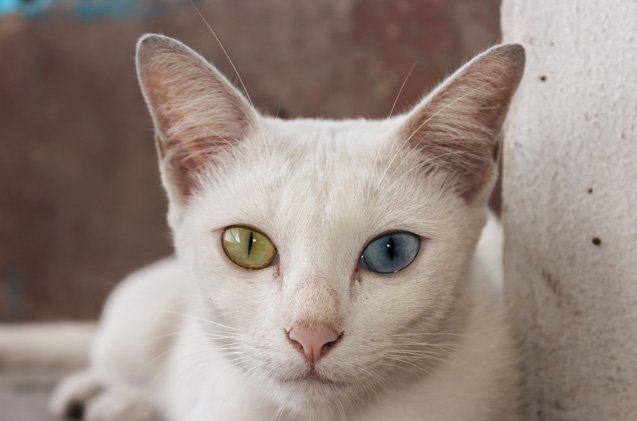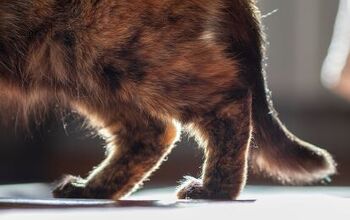Khao Manee


About Khao Manee
Developed in Siam, (now known as Thailand) centuries ago, the Khao Manee was, for hundreds of years, exclusively owned by royalty. They are mentioned in the Thai book of cat poems, the Tamra Maew as the Khao Port or “all white.”
The name Khao Manee translates literally to “White Gem,” and these kitties are also called the Diamond Eye cat. Fiercely protected against export, this breed did not leave Thailand until 1999, when the first one was brought to the United States by Colleen Freymuth, who began a breeding program to preserve these unique animals since their numbers are dwindling in their native land.
This is a natural and beautiful feline breed with a fascinating history. It is not a manufactured or designed breed, and is native to Thailand. This means humans did not have anything to do with its development. However, it is not yet recognized by any cat registries in the United States, and Khao Manee are still quite rare even though they have been approved for exhibition. The Khao Manee Cat Club gained pre-affiliation status with the Governing Council of the Cat Fancy in October 2011.
Even when hearing impaired (often an issue in white cats), the Khao Manee is a playful, active cat that loves attention.
Even when hearing impaired (often an issue in white cats), the Khao Manee is a playful, active cat that loves attention. These kitties are an excellent addition to a family because they get along well with children and with other pets. Because of their fantastic personality traits, and the fact that they enjoy being around people, they can make amazing companions and give you loads of love and laughter.
One thing to consider is that this is a breed that is known for being social, so you do need to be able to provide them with enough interaction, affection, and attention every day. Leaving these kitties alone isn’t a good idea. If owned by a single person, it’s best to have other cats in the house since a solo Khao Manee will get lonely.
These cats require stimulation to be happy and, since they are a close relative to the Siamese, they have the voice to tell you when they’re displeased about something! Loyal and affectionate, the Khao Manee is a definite “people” cat, so this would not be the right breed if you are looking for a kitty that will be fine with being more independent.
Be prepared to buy lots of toys and to participate in one-on-one games with this cat to keep them joyful and healthy. Cat trees that they can climb, perches that they can sit on to view their surroundings, and interactive toys or puzzle toys that stimulate the mind are all great choices when it comes to giving your pet what they need to have fun and thrive.
The Khao Manee is born with a coat that is almost always a lovely pure white color. Some kittens may have a dark patch on their heads, but that disappears within the first year of life. White cats might be hard to come by, so if you really want a pure white kitty to call your own, the Khao Manee might be a good breed to look for.
In addition to the gorgeous white coat, this breed also has another attractive feature that is sure to grab your attention. The Khao Manee’s eyes are one of the most distinctive traits of this breed. Individuals can have two blue eyes, or one blue and one amber or green. (The preference is for the odd eye coloration.) And, when looking into this feline’s eyes, you might notice an amazing starburst pattern around the pupils. Even if you have never seen one of these cats in person, you can probably imagine how incredible they look. It’s no wonder that they are so popular, and such beloved attention grabbers!
Medium sized with the bone structure to match, this breed has somewhat large ears on a wedge-shaped head with prominent cheekbones. In body conformation, these kitties are athletic and muscular. They have a very upright stance with long legs, and have been described as graceful as well.
Some Khao Manee are born partially or completely deaf, which is typical of white cats with blue eyes. However, perhaps because this is a natural breed, the rate of deafness amongst these kitties tends to be lower, which is good news. Nevertheless, there is no reason why you should hesitate to bring a deaf or partially deaf kitty into your family, as they can make amazing pets and can be a lot of fun, just like any other cat.
The Khao Manee is a stunning white cat. Its coat lies close against the body and is sleek and smooth with little to no undercoat. Unlike other feline breeds that can showcase a variety of colors and patterns, this one is known for its white fur and brilliant blue, green, or golden eyes.
The Khao Manee is a low maintenance cat that requires only minimal grooming. The fur is smooth, soft, and short. Since they have almost no undercoat, they shed very little. A weekly brushing should remove any loose hair quite effectively. You can buy a basic brush or comb that is made especially for use on cats and then use it regularly to groom your feline companion. Your cat is sure to enjoy it, and it can even be a way for you to relax and unwind while pampering your furry best friend.
Even if your Khao Manee doesn’t shed a lot, a simple brushing routine can help keep the coat smooth, prevent mats, and help prevent hairballs. Plus, if you are finding that your kitty sheds more during certain seasons of the year, or too much fur is ending up on your furniture, brushing out the loose hairs can help you avoid those problems too.
In addition to taking care of your Khao Manee’s coat, it is also important to check their skin routinely, particularly the area around the ears, since all white cats are prone to developing sunburn and skin cancer, especially if they like to lie in the sun.
Photo credit: peefay/Shutterstock; wasanajai/Shutterstock; sunipix55/Shutterstock

Amy Tokic, Editor of PetGuide.com, is a passionate animal lover and proud pet parent of Oscar, a Shih Tzu/Chihuahua cross, and Zed, a Japanese Chin. Her love of animals began in kindergarten, when she brought her stuffed dog Snoopy into class with her every day. Now, she writes about her adventures in pet ownership and tirelessly researches products, news and health related issues she can share with other animal enthusiasts. In her free time, Amy loves perusing used book and record stores, obsessing over the latest pet products available and chasing squirrels with wild abandon (a habit attributed to spending too much time with her pooches).
More by Amy Tokic

























